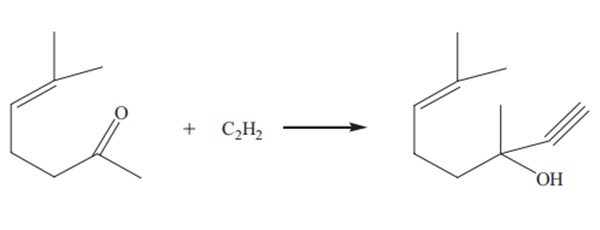Description
3,7-dimethyl-6-octen-1-yn-3-ol, also known as Dehydrolinalool, is a derivative of
methyl heptenone and acetylene. It
is used in small amounts for the production of chemical fragrances for daily use.
Industrial-grade dehydrolinalool (content 92–96%) is mainly used to synthesize a
series of perfumes such as linalool, nerolidol, citral and ionone, which are also important intermediates for the synthesis of vitamin A, E and K. Dehydrolinalool has a strong
ability to mask bad odors, especially for disgusting hydrogen sulfide, garlic preparations and polysulfide odors. In addition, it also has the role of mosquito repellent.
A sterol compound such as dehydrolinalool has excellent antibacterial activity against
Escherichia coli, Enterobacter faecalis, Proteus and the like. Dehydrolinalool has high
added value and is a fine chemical product with broad market prospects.
Chemical Properties
Dehydrolinalool is an acyclic monoterpene alcohol compound with a pleasant floral
vanilla aroma and a spicy and lavender-like fragrance. Its boiling point is 89–93°C
at 1.6 kPa. The constant pressure heat capacity is 385.2 J·mol
-1·K
-1 at 313.55 K. The
enthalpies of vaporization are 50.4 kJ·mol
-1 at 407 K and 52.1 kJ·mol
-1 at 421 K.
Uses
3,7-Dimethyl-6-octen-1-yn-3-ol is a useful synthetic intermediate in the synthesis of Methylisopseudoionone (M314920); a derivative of Ionone (I731275) which is an aroma compound found in essential oils such as rose oil, and thus can be used in the perfumery industry.
Definition
ChEBI: Dehydrolinalool is a ynone.
Application
3,7-dimethyl-6-octen-1-yn-3-ol is an important intermediate for the preparation of β-ionone
and vitamin E. It can be used to produce a series of fragrances such as linalool and
nerolidol. Furthermore, dehydrolinalool is a fragrance ingredient used in decorative
cosmetics, fine fragrances, shampoos, toilet soaps and other toiletries as well as in
non-cosmetic products such as household cleaners and detergents
Synthesis
3,7-dimethyl-6-octen-1-yn-3-ol(Dehydrolinalool) is obtained by ethynylation of methylheptenone with acetylene in
the presence of potassium hydroxide and liquid ammonia.
The specific process is as follows: open the valves of ammonia and acetylene gas cylinders, respectively, add ammonia gas and acetylene to the mixed gas cabinet, and adjust
the ratio of the two gases so that the content of acetylene in the mixed gas cabinet is about
20–25%. The gas mixture is compressed to 2.0–2.5 MPa by a compressor, liquefied in a
high-position cooling tower and enters the reaction tower through a bottom discharge
pipe, and a methylheptene solution containing potassium hydroxide is introduced into
the reaction tower through a metering pump. The reaction temperature is 35–40°C, the
reaction pressure is 2.0–2.5 MPa and the reaction time is 2–3 h. The reaction liquid enters
the flash tank through the discharge tube of the reaction tower, and the flashing temperature is 50–70°C. Excess acetylene and ammonia are flashed and recycled back to
the mixing gas cabinet, and the reaction product overflows from the bottom of the flash
tank to the storage tank. By distillation under reduced pressure, dehydrolinalool having
a mass fraction of more than 98% can be obtained and the yield can reach 92–94%.






